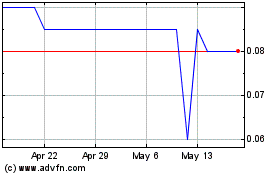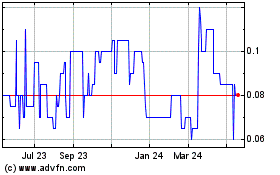Compass Gold Corp. (TSX-V: CVB) (Compass or
the Company) announces results from the recently
completed diamond core drilling program at the Farabakoura
artisanal workings on the Ouassada permit, Sikasso Property in
southern Mali.
Highlights
- Diamond drilling at Farabakoura intercepts high-grade
gold mineralization in bedrock, including:
6.1 m @ 65.6 grams per tonne (g/t) gold (Au) from 19.5 m
(OUDD004) 13 m @ 9.25 g/t Au from 21.1
m (OUDD006) 7.1 m @ 2.13 g/t Au from
68.9 m (OUDD007) 7.0 m @ 1.45 g/t Au
from 76 m (OUDD008)
- All seven diamond drill holes (total 995 m) intersected
significant gold mineralization within a 200 m section of the 750 m
long Farabakoura high-grade zone
- Follow-up drilling in Q4 will test open areas and
extent of gold rich zone
Compass CEO, Larry Phillips,
said, “The conclusion of this season’s drilling at Farabakoura has
returned some spectacular high-grade gold intercepts over an
extensive area, as well as valuable new structural and geologic
data that continues to excite our team. In addition to
finding such strong gold values, this work has revealed new
structures with significant potential that we will begin drilling
in Q4 once the rainy season ends.”
Creek Zone Diamond Drilling
Results The diamond core results reported here supplement
reverse circulation (RC) drilling carried out at the Creek Zone at
Farabakoura during April and June 2019 (see press releases dated
May 15 and July 29, 2019). The purpose of this latest
seven-hole (995 m) diamond drilling program was to test the downdip
continuity of an extensive mineralized zone (450 m in length) and
provide critical information on the nature of the gold-bearing
veins.
The Creek Zone is part of a semi-continuous zone
of gold mineralization that is present over a distance of 760 m,
and displays apparent widths up to 60 m (grading 1.42 g/t Au,
OURC011), and sporadic high-grade samples (e.g., OUDD001).
Visible gold was previously reported in OUDD001, where three
discrete mineralized intervals were identified within a wider 18 m
interval containing 4 m @ 83.82 g/t Au (from 63 m); 4 m @ 7.04 g/t
Au (from 69 m); and 3 m @ 4.18 g/t Au (from 78 m.) (see
Compass release dated March 28, 2019).
Drilled over a distance of 200 m (see Figure 1,)
all seven diamond holes (OUDD002 to OUDD008) intercepted gold.
Six of these latest holes were drilled to test the down dip
extension of gold mineralization previously identified from RC
drilling and present in two large artisanal pits where high-grade
gold was recovered. The holes farthest from the river
contained the highest grades and the widest intervals.
OUDD004, which was collared approximately 380 m SE of the above
noted OUDD001, contained 6.1 m @ 65.6 g/t Au (from
19.5 m).
Located between these two holes, OUDD006
contained 13.5 m @ 9.25 g/t Au (from 21.1 m),
including 1.5 m @ 30.75 g/t Au (from 31.6
m). Visible gold was observed in two intervals in OUDD003
(0.4 m @ 5.74 g/t Au from 35.8 m) and in OUDD007 (1.5 m @ 5.93 g/t
Au).
The seventh new drill hole, OUDD008, was
designed to test the hypothesis that mineralized veins might have
different orientations. Initial interpretation of the earlier RC
drilling suggested mineralization was likely orientated in a NW-SE
direction and closely associated with the contact between an
intrusive rock (granodiorite) and the country rocks.
Mineralization generally occurred in individual
veins containing quartz-tourmaline-pyrite that vary from 5 cm to 1
m (true width), and are orientated in two directions, dominantly
NE-SW, and a secondary E-W direction. This indicates the
previously postulated NW-SE trending Farabakoura Pit Structure is
related to a geological boundary, but apparently does not control
mineralization. The new interpretation suggests additional
mineralization will likely be present along these open structures,
up to 500 m in length, and this will be tested by further RC
drilling following the rainy season.
Figure
1. Location of the diamond drill holes
(labeled) at Farabakoura mentioned in this release plotted on
compiled geology. Interpreted vein traces from diamond and RC
drilling are also illustrated. A photo accompanying this
announcement is available at
https://www.globenewswire.com/NewsRoom/AttachmentNg/41a1bdf6-ea8b-4a92-82d9-fe790fcafd22
|
Table 1. Significant assays (>0.5 g/t Au)
during recent drilling at Farabakoura |
|
Hole ID |
From |
To |
1, 2Interval |
Gold |
|
(m) |
(m) |
(m) |
(g/t) |
|
OUDD002 |
37.5 |
40 |
2.5 |
2.87 |
|
OUDD003 |
35.1 |
38 |
2.9 |
1.65 |
|
including |
35.8 |
36.2 |
0.4 |
*5.74 |
|
|
53 |
54 |
1 |
1.7 |
|
|
67 |
68.1 |
1.1 |
0.68 |
|
|
69.4 |
70.3 |
0.9 |
1.19 |
|
|
72 |
73 |
1 |
0.95 |
|
|
74 |
75 |
1 |
1.65 |
|
|
83 |
83.5 |
0.5 |
0.63 |
|
|
102.3 |
103.5 |
1.2 |
1.55 |
|
OUDD004 |
19.5 |
25.6 |
6.1 |
65.58 |
|
including |
20.5 |
23.5 |
3 |
130.23 |
|
including |
21.5 |
22.5 |
1 |
237.7 |
|
OUDD005 |
44.5 |
51.5 |
7 |
2.30 |
|
OUDD006 |
7.6 |
9.1 |
1.5 |
0.58 |
|
|
21.1 |
34.6 |
13.5 |
9.25 |
|
including |
25.6 |
28.6 |
2 |
17.53 |
|
including |
31.6 |
33.1 |
1.5 |
30.76 |
|
|
158 |
159 |
1 |
2.36 |
|
OUDD007 |
22.6 |
29.6 |
7 |
0.66 |
|
|
56.3 |
56.6 |
0.3 |
9.53 |
|
|
68.9 |
76 |
7.1 |
2.13 |
|
including |
68.9 |
69.7 |
1.5 |
*5.93 |
|
including |
74 |
75.5 |
1.5 |
2.78 |
|
|
78.6 |
80 |
1.4 |
2.25 |
|
OUDD008 |
32.6 |
33.6 |
1 |
8.57 |
|
|
39.6 |
40.6 |
1 |
1.09 |
|
|
42.6 |
43.6 |
1 |
1.13 |
|
|
73 |
83 |
10 |
1.06 |
|
including |
76 |
83 |
7 |
1.45 |
|
|
89 |
90 |
1 |
2.51 |
|
|
105 |
109 |
4 |
1.41 |
|
including |
106.4 |
106.7 |
0.3 |
11.82 |
| 1True thicknesses
are interpreted as 50-90% of stated intervals, except OUDD008 where
this true thickness is interpreted to be 60-100% of the stated
interval; 2 Intervals use a 0.2-g/t gold cut-off value; 3 Within a
zone of poor core recovery; * Sample contains visible gold. |
| |
Figure 2.
Location of the high-priority exploration targets on Ouassada and
Faraba-Coura identified by the presence of artisanal gold workings,
favourable structures and geochemical anomalism. The
Siékorolé Shear Zone is illustrated in dark grey and artisanal
workings outlined in purple. A photo accompanying this announcement
is available at
https://www.globenewswire.com/NewsRoom/AttachmentNg/6a436216-4663-4a5d-b991-23eae6620331
Next Steps
Compass will launch the next phase of drilling
focused at Farabakoura and surrounding areas as soon as the rainy
season ends to test the areas surrounding the latest diamond
drilling and to determine the extent of mineralization within this
highly prospective gold zone. This will include 2,000 m of RC
at Farabakoura and the nearby Kabangoué target area.
A drill program of up to 2,000-m RC is also
planned for the area immediately north of Farabakoura on the
previously announced Boumban (Figure 2) target (see Compass press
release dated August 26, 2019). We intend to conduct
additional RC reconnaissance drilling for the first half of 2020 on
the best target areas on the Company’s Sankarani permit and
Yanfolila South block that have been identified through previous
field work.
Further ground geophysical surveying (gradient
induced polarization) will also be conducted to test structural and
geochemical targets on all permits.
About Compass Gold Corp.
Compass, a public company having been
incorporated into Ontario, is a Tier 2 issuer on the TSX- V.
Through the 2017 acquisition of MGE and Malian subsidiaries,
Compass holds gold exploration permits located in Mali that
comprise the Sikasso Property. The exploration permits
are located in three sites in southern Mali with a combined land
holding of 854 km2. The Sikasso Property is
located in the same region as several multi-million ounce gold
projects, including Morila, Syama, Kalana and Kodiéran. The
Company’s Mali-based technical team, led in the field by Dr. Madani
Diallo and under the supervision of Dr. Sandy Archibald, P.Geo, is
initiating a new exploration program. They are examining the first
of numerous anomalies noted for further investigation in Dr.
Archibald’s August 2017 “National Instrument 43-101 Technical
Report on the Sikasso Property, Southern Mali.”
QAQC
All diamond core samples were collected
following industry best practices, and an appropriate number and
type of certified reference materials (standards), blanks and
duplicates were inserted to ensure an effective QAQC program was
carried out. The core was sampled in its entirety, with
sample intervals varying from 0.20 to 1.50 m to accurately reflect
the mineralization present. Samples were prepared and
analyzed at SGS SARL (Bamako, Mali) by fire assay technique FAE505.
All standard and blank results were reviewed to ensure no
failures were detected.
Qualified Person
This news release has been reviewed and approved
by EurGeol. Dr. Sandy Archibald, P.Geo, Compass’s Technical
Director, who is the Qualified Person for the technical information
in this news release under National Instrument 43-101
standards.
Forward‐Looking InformationThis
news release contains "forward‐looking information" within the
meaning of applicable securities laws, including statements
regarding the Company’s planned exploration work and management
appointments. Readers are cautioned not to place undue reliance on
forward‐looking information. Actual results and developments may
differ materially from those contemplated by such information. The
statements in this news release are made as of the date hereof. The
Company undertakes no obligation to update forward‐looking
information except as required by applicable law.
For further information please contact:
|
Compass Gold Corporation |
Compass Gold Corporation |
|
Larry Phillips – Pres. & CEO |
Greg Taylor – Dir. Investor Relations & Corporate
Communications |
|
lphillips@compassgoldcorp.com |
gtaylor@compassgoldcorp.com |
|
T: +1 416-596-0996 X 302 |
T: +1 416-596-0996 X 301 |
| |
|
Website: www.compassgoldcorp.com
NEITHER THE TSX VENTURE EXCHANGE NOR ITS
REGULATION SERVICES PROVIDER (AS THAT TERM IS DEFINED IN THE
POLICIES OF THE TSX VENTURE EXCHANGE) ACCEPTS RESPONSIBILITY FOR
THE ADEQUACY OR ACCURACY OF THIS RELEASE.
Compass Gold (TSXV:CVB)
Historical Stock Chart
From Dec 2024 to Jan 2025

Compass Gold (TSXV:CVB)
Historical Stock Chart
From Jan 2024 to Jan 2025
